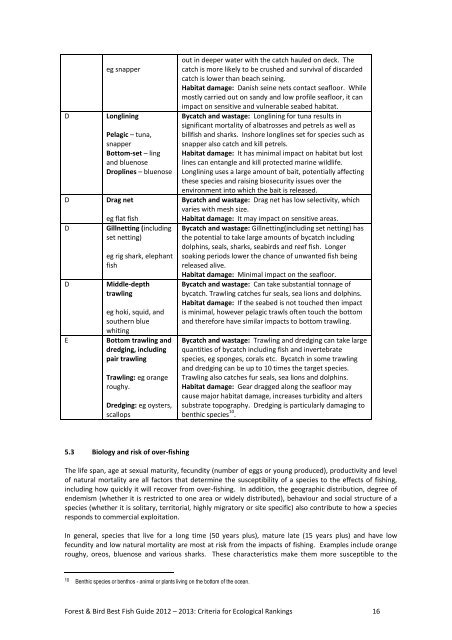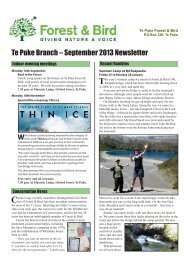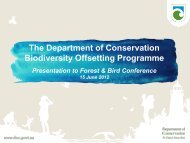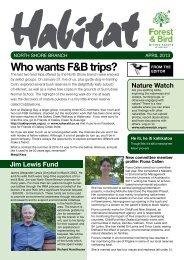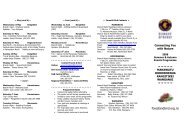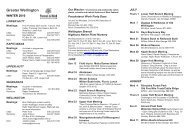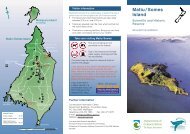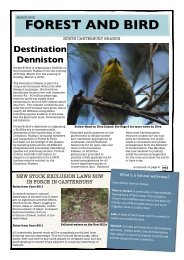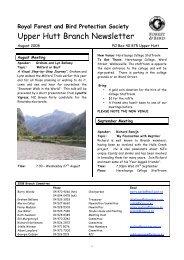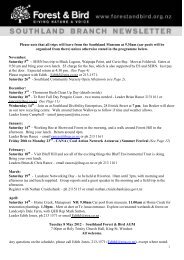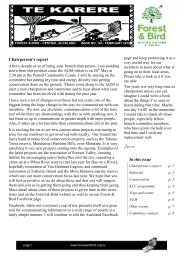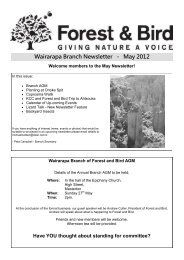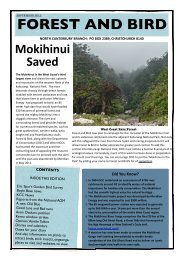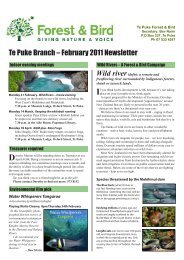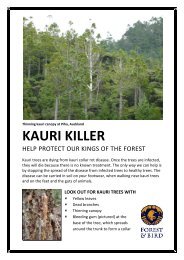methodology - Forest and Bird
methodology - Forest and Bird
methodology - Forest and Bird
Create successful ePaper yourself
Turn your PDF publications into a flip-book with our unique Google optimized e-Paper software.
eg snapper<br />
D Longlining<br />
D Drag net<br />
Pelagic – tuna,<br />
snapper<br />
Bottom-set – ling<br />
<strong>and</strong> bluenose<br />
Droplines – bluenose<br />
eg flat fish<br />
D Gillnetting (including<br />
set netting)<br />
eg rig shark, elephant<br />
fish<br />
D Middle-depth<br />
trawling<br />
eg hoki, squid, <strong>and</strong><br />
southern blue<br />
whiting<br />
E Bottom trawling <strong>and</strong><br />
dredging, including<br />
pair trawling<br />
Trawling: eg orange<br />
roughy.<br />
Dredging: eg oysters,<br />
scallops<br />
5.3 Biology <strong>and</strong> risk of over-fishing<br />
out in deeper water with the catch hauled on deck. The<br />
catch is more likely to be crushed <strong>and</strong> survival of discarded<br />
catch is lower than beach seining.<br />
Habitat damage: Danish seine nets contact seafloor. While<br />
mostly carried out on s<strong>and</strong>y <strong>and</strong> low profile seafloor, it can<br />
impact on sensitive <strong>and</strong> vulnerable seabed habitat.<br />
Bycatch <strong>and</strong> wastage: Longlining for tuna results in<br />
significant mortality of albatrosses <strong>and</strong> petrels as well as<br />
billfish <strong>and</strong> sharks. Inshore longlines set for species such as<br />
snapper also catch <strong>and</strong> kill petrels.<br />
Habitat damage: It has minimal impact on habitat but lost<br />
lines can entangle <strong>and</strong> kill protected marine wildlife.<br />
Longlining uses a large amount of bait, potentially affecting<br />
these species <strong>and</strong> raising biosecurity issues over the<br />
environment into which the bait is released.<br />
Bycatch <strong>and</strong> wastage: Drag net has low selectivity, which<br />
varies with mesh size.<br />
Habitat damage: It may impact on sensitive areas.<br />
Bycatch <strong>and</strong> wastage: Gillnetting(including set netting) has<br />
the potential to take large amounts of bycatch including<br />
dolphins, seals, sharks, seabirds <strong>and</strong> reef fish. Longer<br />
soaking periods lower the chance of unwanted fish being<br />
released alive.<br />
Habitat damage: Minimal impact on the seafloor.<br />
Bycatch <strong>and</strong> wastage: Can take substantial tonnage of<br />
bycatch. Trawling catches fur seals, sea lions <strong>and</strong> dolphins.<br />
Habitat damage: If the seabed is not touched then impact<br />
is minimal, however pelagic trawls often touch the bottom<br />
<strong>and</strong> therefore have similar impacts to bottom trawling.<br />
Bycatch <strong>and</strong> wastage: Trawling <strong>and</strong> dredging can take large<br />
quantities of bycatch including fish <strong>and</strong> invertebrate<br />
species, eg sponges, corals etc. Bycatch in some trawling<br />
<strong>and</strong> dredging can be up to 10 times the target species.<br />
Trawling also catches fur seals, sea lions <strong>and</strong> dolphins.<br />
Habitat damage: Gear dragged along the seafloor may<br />
cause major habitat damage, increases turbidity <strong>and</strong> alters<br />
substrate topography. Dredging is particularly damaging to<br />
benthic species 10 .<br />
The life span, age at sexual maturity, fecundity (number of eggs or young produced), productivity <strong>and</strong> level<br />
of natural mortality are all factors that determine the susceptibility of a species to the effects of fishing,<br />
including how quickly it will recover from over-fishing. In addition, the geographic distribution, degree of<br />
endemism (whether it is restricted to one area or widely distributed), behaviour <strong>and</strong> social structure of a<br />
species (whether it is solitary, territorial, highly migratory or site specific) also contribute to how a species<br />
responds to commercial exploitation.<br />
In general, species that live for a long time (50 years plus), mature late (15 years plus) <strong>and</strong> have low<br />
fecundity <strong>and</strong> low natural mortality are most at risk from the impacts of fishing. Examples include orange<br />
roughy, oreos, bluenose <strong>and</strong> various sharks. These characteristics make them more susceptible to the<br />
10 Benthic species or benthos - animal or plants living on the bottom of the ocean.<br />
<strong>Forest</strong> & <strong>Bird</strong> Best Fish Guide 2012 – 2013: Criteria for Ecological Rankings 16


